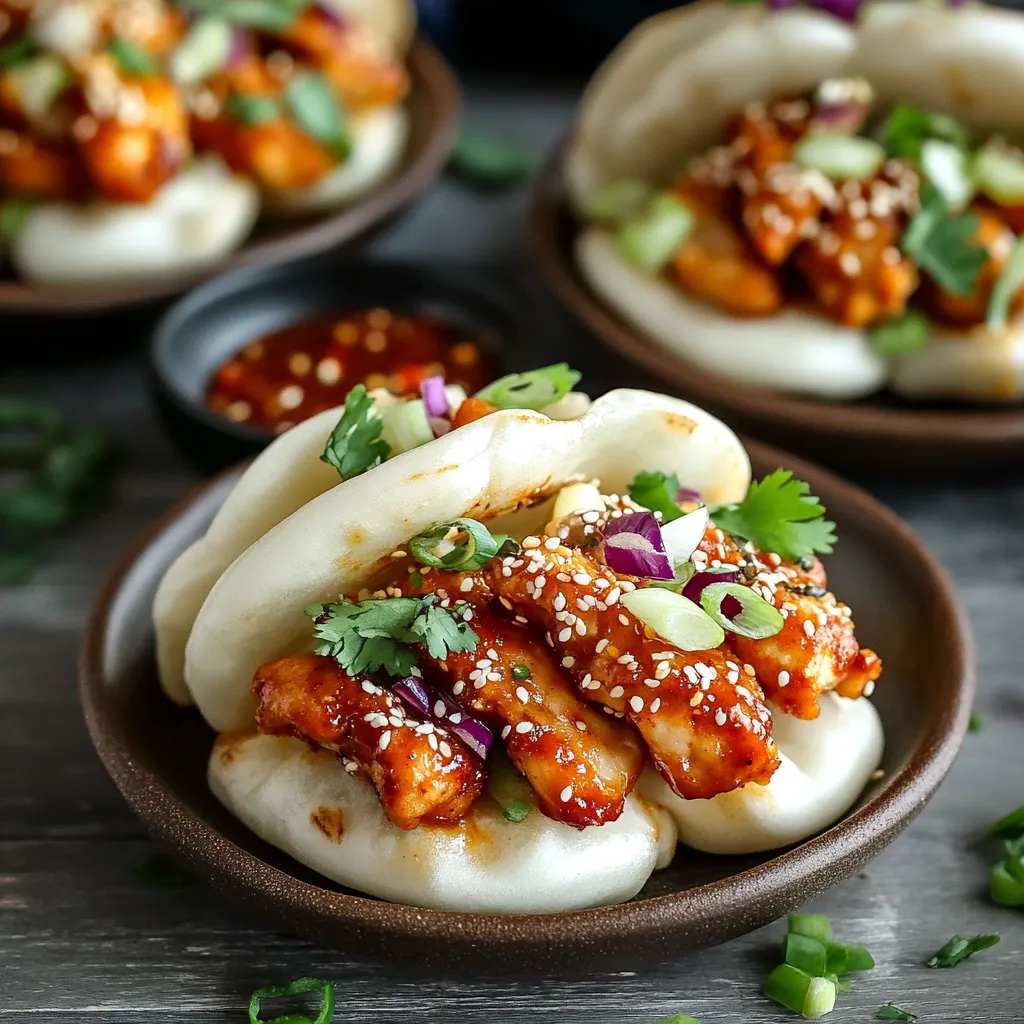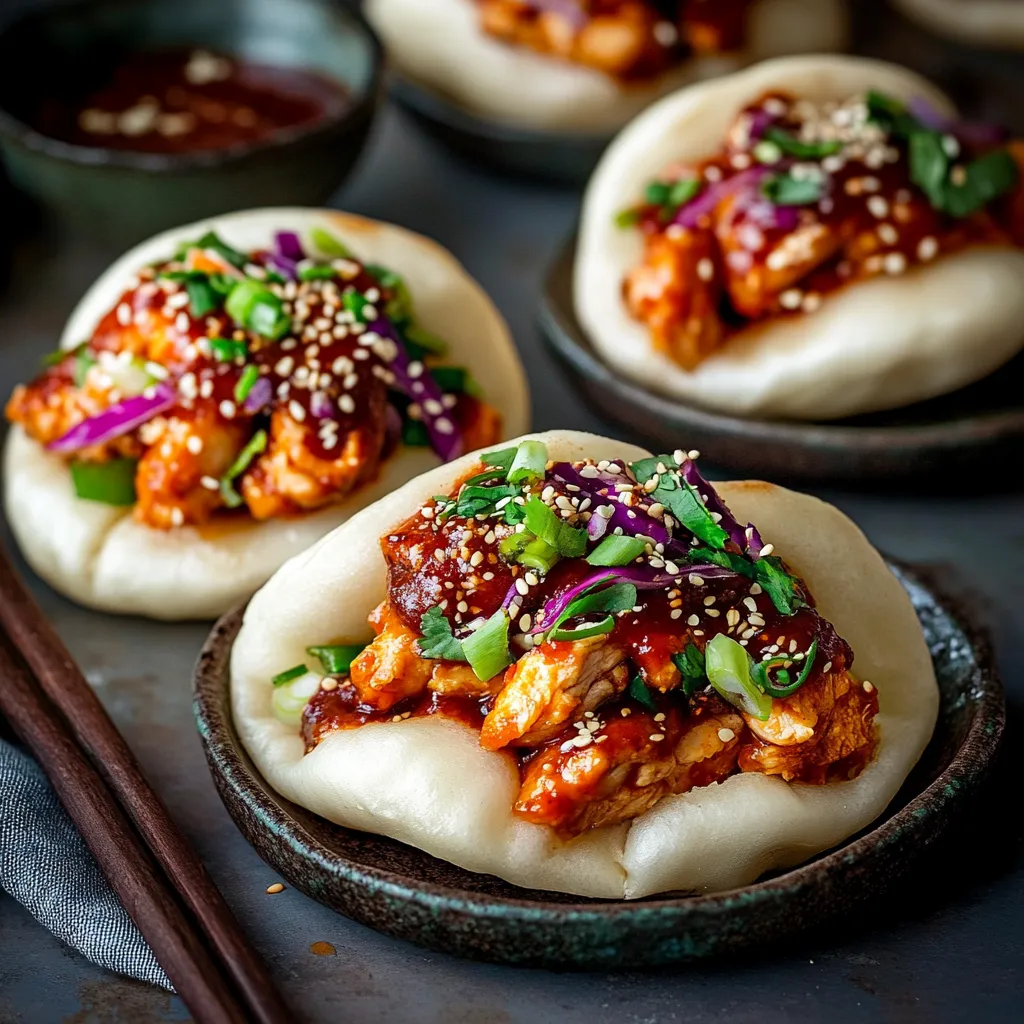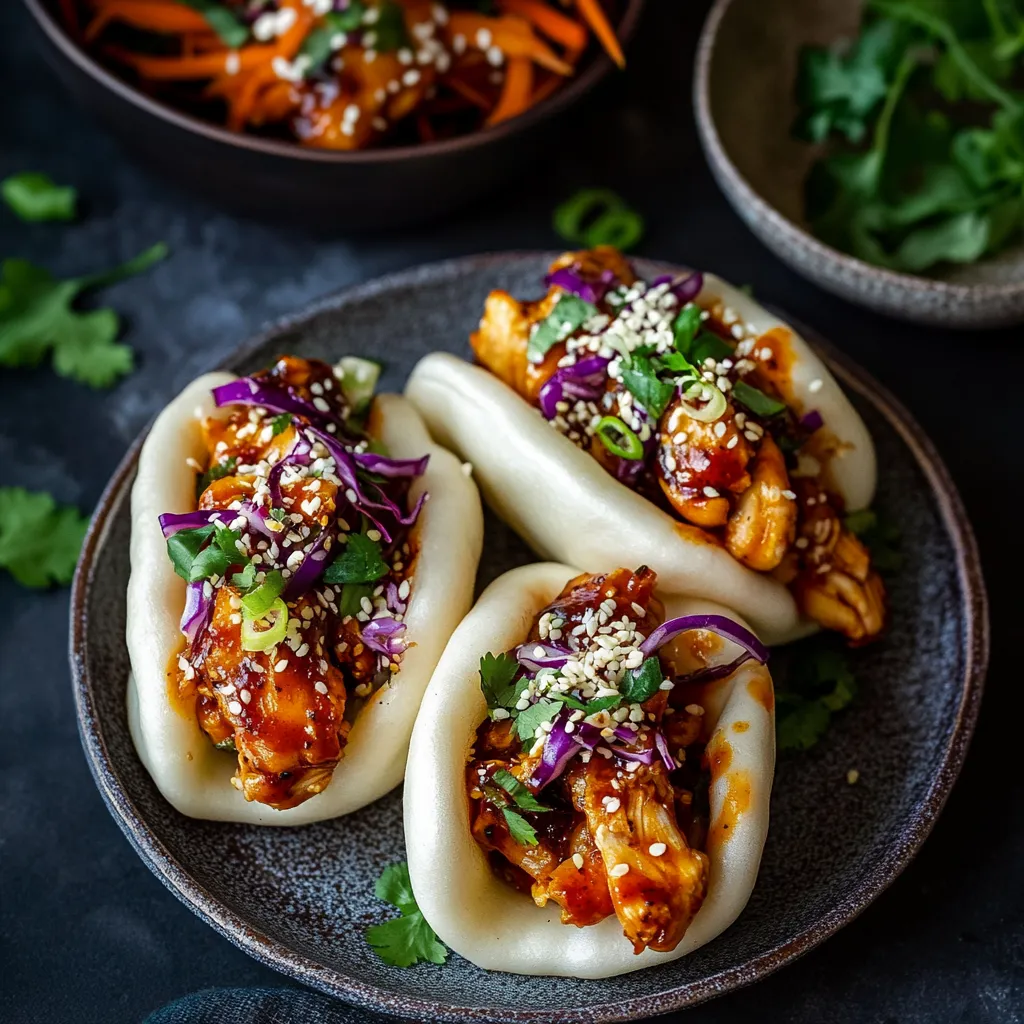 Pin it
Pin it
Soft and fluffy steamed mini bao buns filled with crispy Korean chicken create an impressive and sophisticated party food that never fails to impress guests. These pillowy buns cradle perfectly crisp chicken coated in a sweet-spicy gochujang sauce, creating a flavor explosion with every bite. The contrast between the delicate bao and the bold, flavorful chicken makes these little bundles absolutely irresistible.
I first tried making these bao buns after returning from a trip to Seoul where I sampled them from a street vendor. My first few attempts were disasters—either too dense or improperly steamed. After much experimentation and several batches later, I finally cracked the code to achieving that perfectly pillowy texture that makes these buns so special.
Bao Bun Components
- All-purpose flour: Forms the foundation of our bao dough, providing structure while maintaining lightness when properly activated
- Active dry yeast: Creates the essential rise and airy texture; always check the expiration date for optimal results
- Sugar: Feeds the yeast and adds subtle sweetness that complements the savory filling
- Warm milk and water: Activates the yeast while adding richness to the dough
- Butter: Introduces a subtle richness that makes these buns irresistibly tender
- Salt: Enhances flavors and controls yeast activity for properly textured buns
Bao Preparation
- Dough Creation:
- Combine two cups flour with one tablespoon sugar, half teaspoon salt, and one teaspoon active dry yeast in a large mixing bowl, whisking thoroughly to distribute ingredients evenly. Heat three-quarters cup milk with quarter cup water and two tablespoons butter until warm and butter melts completely. Pour liquid mixture into flour mixture and stir until shaggy dough forms, then transfer to floured surface.
- Kneading Process:
- Work the dough vigorously for ten full minutes, pushing forward with palm then folding back repeatedly until smooth and elastic. The dough should spring back when poked and feel slightly tacky but not sticky. Place in lightly oiled bowl, cover with damp cloth, and allow to rise in warm spot for ninety minutes until doubled in volume.
- Shaping Technique:
- Punch down risen dough gently to release air bubbles, then divide into twenty equal portions. Roll each portion into smooth ball, then flatten and roll into oval shapes approximately three inches long. Lightly brush surface with sesame oil, then fold over using chopstick pressed across middle to create characteristic bao shape with small gap for filling.
- Steaming Method:
- Arrange shaped buns on parchment squares, place in steamer basket with two inches between each bun, cover with lid, and allow to proof again for sixty minutes until puffy. Bring water to vigorous boil beneath steamer, then cook buns for exactly ten minutes. Remove immediately after cooking to prevent condensation from making them soggy.
 Pin it
Pin it
I personally love working with this bao dough because it's so forgiving compared to many other breads. My grandmother taught me to test dough readiness by pressing gently with one finger—if it springs back halfway, it's perfectly proofed. This simple technique has saved countless batches from being over or under proofed and creates that perfect texture every time.
Chicken Preparation
- Marination Process:
- The crispy Korean chicken filling starts with boneless thighs cut into bite-sized pieces that get marinated in buttermilk seasoned with garlic salt, white pepper, and regular salt. This tenderizing bath should last at least one hour but works magic if left overnight in the refrigerator. The tangy buttermilk breaks down proteins in the meat, ensuring juicy chicken even after frying.
- Crispy Coating:
- After marinating, each piece gets coated in a special crispy coating mixture combining flour, cornstarch, baking powder, salt, garlic powder, onion powder, and white pepper. This combination creates the perfect crunch without becoming too heavy or dense. Fry the coated chicken pieces in vegetable oil at 350°F until golden brown and cooked through, which typically takes about four minutes per batch.
- Gochujang Sauce:
- The signature gochujang sauce transforms ordinary fried chicken into something extraordinary. Simmer gochujang paste with honey, brown sugar, soy sauce, minced garlic, grated ginger, rice vinegar, and sesame oil until thick and glossy. This sauce should coat the back of a spoon and have a balance of sweet, savory, and spicy notes. Toss the freshly fried chicken in this sauce just before assembling the bao buns.
Perfect Pairings
Fresh companions enhance these Korean chicken bao buns beautifully. Thinly sliced cucumber provides cooling crispness against the spicy chicken, while quick-pickled red onions add tangy crunch and vibrant color. Fresh cilantro leaves bring herbaceous brightness, and a sprinkle of toasted sesame seeds adds nutty depth and visual appeal. For additional texture contrast, consider adding thinly sliced radishes or shredded carrots.
Creative Adaptations
Transform this recipe with thoughtful substitutions tailored to dietary needs or flavor preferences. Replace chicken with crispy tofu or tempeh for vegetarian versions, using the same marinade and coating techniques. Adjust spice levels by reducing gochujang amount or balancing with extra honey for milder palates. Experiment with different herbs like Thai basil or mint instead of cilantro for interesting flavor variations.
Freshness Maintenance
Proper storage ensures these delightful buns remain enjoyable for days after preparation. Store uncooked bao dough in refrigerator for up to 24 hours, allowing it to come to room temperature before shaping. Cooked unfilled bao buns freeze beautifully for up to three months when placed in airtight containers with parchment between layers. Reheat frozen buns by steaming for five minutes until soft and pillowy again.
 Pin it
Pin it
These Korean Chicken Bao Buns represent the perfect marriage of textures and flavors that make Asian fusion cuisine so endlessly fascinating. I've served these at countless gatherings where they've consistently disappeared within minutes, with guests hovering near the kitchen hoping for the next batch. While they require some time investment, the reactions and satisfaction they bring make every minute worthwhile.
Frequently Asked Questions
- → Can I make Korean Chicken Bao ahead of time?
- Yes, you can make the bao buns and chicken ahead. Store the buns in the refrigerator for up to 2 days or freeze them. The chicken can be made a day ahead and reheated in the oven at 380°F for 10-15 minutes. For best results, keep the sauce separate until serving.
- → How do I reheat bao buns?
- Refrigerated bao buns can be reheated in a microwave for 15-20 seconds each or steamed for 4-5 minutes. Frozen buns can be steamed for 5-6 minutes without thawing.
- → Can I bake the chicken instead of frying?
- Yes, you can bake the chicken instead of frying. Follow a baked chicken tender recipe and then toss the cooked chicken in the spicy gochujang sauce.
- → What is gochujang paste?
- Gochujang is a Korean red chili paste that's fermented and has a sweet, spicy, and slightly funky flavor. It's a key ingredient in Korean cooking and can be found in Asian grocery stores or the international section of many supermarkets.
- → How many bao buns does this recipe make?
- This recipe makes 20 Korean Chicken Bao, which is perfect for serving at parties or gatherings.
